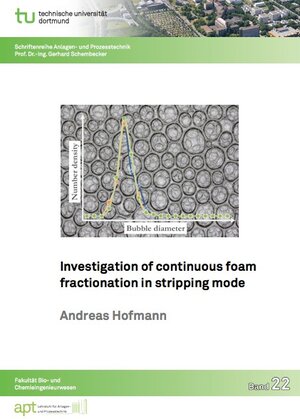
×
![Buchcover ISBN 9783843932776]()
Investigation of continuous foam fractionation in stripping mode
von Andreas HofmannContinuous foam fractionation is a well-known technique for selectively separating surface-active molecules from aqueous solutions. Due to the amphiphilic nature of proteins and enzymes, foam fractionation is seen as an innovative separation method for downstream processing of biochemical processes.
The focus of this thesis was the theoretical and experimental investigation of the foam fractionation process operated in stripping mode to gain more process knowledge. To investigate the role of the bubble size for the performance of a foam fractionation process, an optical method for determining bubble size distributions was developed and validated. Additionally, a simple and reproducible foam sampling tool was developed enabling the measurement of liquid fraction and concentration profiles along the foam height. Thus, for the first time it was shown that the foam bed could be characterized with one single bubble size, the mean Sauter diameter d32, mean, and the corresponding liquid fraction εL and that the bubble size directly controlled the separation efficiency.
As there was no existing model describing concentration changes along the foam height, three different models were developed and investigated in detail by comparing simulated and measured foam concentration profiles: an ideal stage model, a mass transfer model and a true moving bed approach (TMB). The mass transfer model turned out to successfully simulate the concentration profiles inside the foam for a broad range of operating conditions, limited only to relatively wet foams and high ratios of superficial feed to gas velocity. The true moving bed approach seemed to be over-designed since axial dispersion was of less importance indicated by axial dispersion coefficients Dax scattering over several orders of magnitude for the whole range of operating conditions. The ideal stage model was not suitable for wet foams but it dominated in case of dry foams showing better fits compared to the other two models.
The focus of this thesis was the theoretical and experimental investigation of the foam fractionation process operated in stripping mode to gain more process knowledge. To investigate the role of the bubble size for the performance of a foam fractionation process, an optical method for determining bubble size distributions was developed and validated. Additionally, a simple and reproducible foam sampling tool was developed enabling the measurement of liquid fraction and concentration profiles along the foam height. Thus, for the first time it was shown that the foam bed could be characterized with one single bubble size, the mean Sauter diameter d32, mean, and the corresponding liquid fraction εL and that the bubble size directly controlled the separation efficiency.
As there was no existing model describing concentration changes along the foam height, three different models were developed and investigated in detail by comparing simulated and measured foam concentration profiles: an ideal stage model, a mass transfer model and a true moving bed approach (TMB). The mass transfer model turned out to successfully simulate the concentration profiles inside the foam for a broad range of operating conditions, limited only to relatively wet foams and high ratios of superficial feed to gas velocity. The true moving bed approach seemed to be over-designed since axial dispersion was of less importance indicated by axial dispersion coefficients Dax scattering over several orders of magnitude for the whole range of operating conditions. The ideal stage model was not suitable for wet foams but it dominated in case of dry foams showing better fits compared to the other two models.


